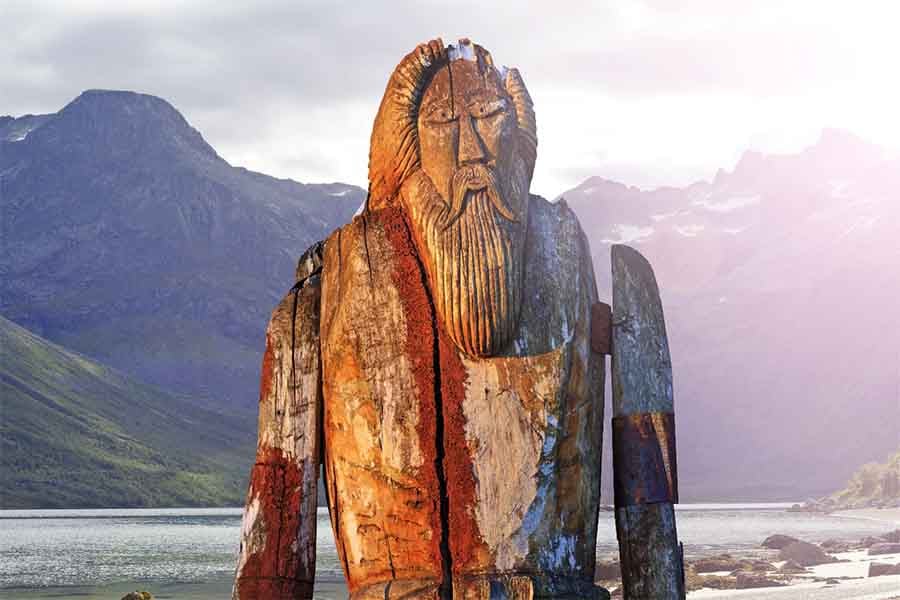The Norse God Odin: Viking God of War, Father of Thor, But There’s More
Odin is the chief deity of the Norse pantheon. Although Odin was worshipped more generally in Germanic paganism, the information we have today about this god is derived mostly from Norse mythology. These pieces of information include both written sources, such as myths, and archaeological finds, that combined paint a complex picture of this Norse (Viking) god. Consequently, it is difficult to figure out Odin’s exact role and character. Nevertheless, in general, Odin is viewed as a wise deity, in addition to his role as the Norse god of war. Apart from that, he was also associated with death, poetry, magic, and prophecy. As the primary god of the Norse pantheon, Odin plays an important role in many myths. And he was also the father of the mighty Thor, who is so loved in modern popular culture for his strength.
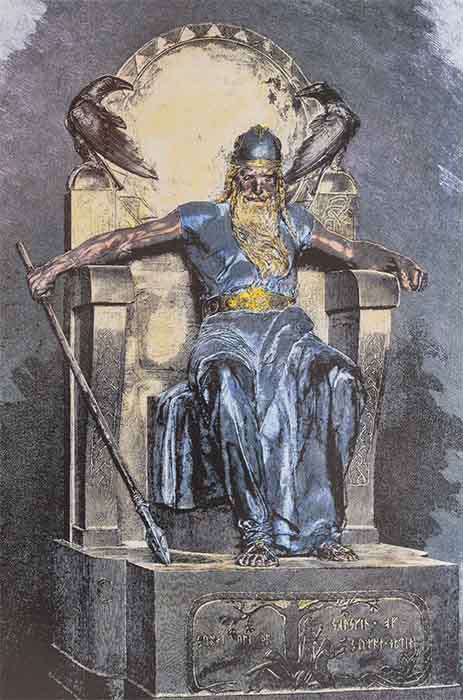
Odin, the supreme god in Norse mythology, on his throne with his magical ravens. (Juan Aunión / Adobe Stock)
The Norse God Odin Was Also a Primary Germanic Deity
The name Odin is said to be derived from Proto-Germanic “Wodanaz,” which may be translated variously to mean “the fury,” “the furious,” “the inspired,” and “the inspiring.” One of the earliest textual references to the god Odin is found in Germania, written by the Roman historian Tacitus in the 1st century AD. In his work, Tacitus wrote that the “Of all the gods, Mercury is he whom they worship most. To him on certain stated days it is lawful to offer even human victims.” It has been pointed out that since Mercury’s day was identified as Wednesday, or “Woden’s day,” Tacitus was referring to Odin when he mentioned that the ancient Germans worshipped Mercury.
- Were Vikings in South America Over 400 Years Before Columbus?
- Norse Mythology: Tales of Norse Gods, Heroes, Beliefs, Rituals & the Viking Legacy
Tacitus’ statement, however, must be taken with a pinch of salt. Whilst Odin was certainly a major deity amongst the ancient Germans, there is insufficient evidence to show that his cult was primary to all the Germanic tribes. In other words, Tacitus may have been making a sweeping generalization about the religious beliefs of the people he was writing about. Additionally, it has been suggested that whilst the elites may have venerated Odin, he may have been less popular amongst the common people compared to his son, Thor.
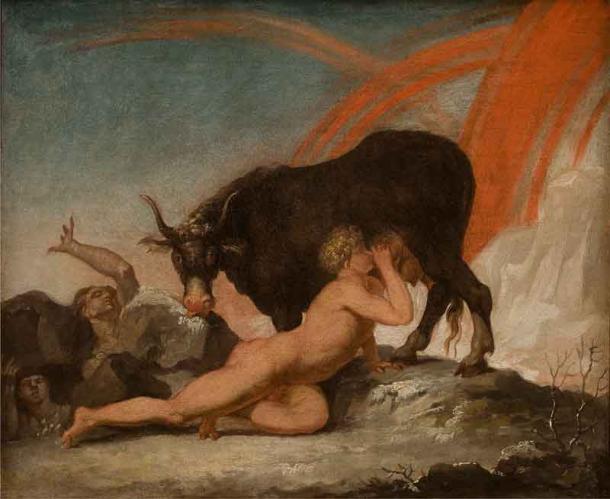
Ymir, the first Norse jotunn giant, sucks at the udder of Auðumbla as she licks Búri out of the ice in a painting by Nicolai Abildgaard, 1790. (Nicolai Abildgaard / CC0)
Odin: The Viking Creator God And His Many Children
One of Odin’s many epithets was “All-father.” Apart from the belief that he fathered many gods with various women (more about which in a moment), Odin was also regarded as a creator god. According to one myth, in the beginning, there was a vast emptiness called Ginnungagap. From this nothingness, two realms, Niflheim and Muspelheim, emerged. Niflheim was located to the north of Ginnungagap, and was an extremely cold place, with nothing but ice, frost, and fog. Muspelheim, by contrast, formed in the south of Ginnungagap, and was a hot place, with only fire, lava, and smoke.
In spite of these harsh conditions, life appeared. In Niflheim was a spring called Hvergelmir, which the Norse believed was the source of all the cold rivers. There were 11 cold rivers, collectively known as Elivagar. The water from these rivers flowed from the mountains to the plain of Ginnungagap, where it froze, forming a solid layer of ice. As time went by, the ice layer expanded. At the same time, lava was flowing from Muspelheim onto the plain of Ginnungagap. Eventually, the two met in the middle of Ginnungagap.
The meeting of the hot and cold elements resulted in the melting of the ice. The melted ice began to drip, and a human-like creature began to form in the ice. This was Ymir, the first jotunn, or giant, in Norse mythology.
When Ymir slept, he began to sweat, and from these bodily fluids, two more giants, one male, and the other female, were born. Additionally, a third giant, another son called Thrudgelmir (meaning “Strength Yeller”) was born when one of Ymir’s legs paired with the other. The children of Ymir were the first of the frost giants, and were breastfed by Audhumbla, a giant cow, who, like Ymir, was created from the melting of the ice in Ginnungagap.
- Ancient Gods – When Darkness Ruled the World
- Divine, Forbidden and Dangerous? Magic Apples in Ancient Mythology
Audhumbla nourished herself by licking a block of salty ice. It was from this action that the first Norse god came into being. On the first day that the giant cow licked the block of salty ice, some human hair appeared. On the second day, a head emerged, and on the third, the rest of the body was freed. This was Buri, the first of the gods. Buri, through some unknown process, fathered a son, Borr, who later took Bestla (believed to be a jotunn) as his wife. Borr and Bestla were the parents of Odin, Vili, and Ve, the first of the Aesirs, one of the two main groups of gods in Norse mythology.
The three brothers noticed that the Aesirs were outnumbered by the jotnar, who were producing new giants at a rapid pace. They reasoned that the only way to solve this problem was to kill Ymir. Therefore, Odin and his brothers waited for the giant to fall asleep, before attacking him. Ymir, however, woke up, and a terrible fight ensued. In the end, Ymir was slain. So much blood flowed from the jotunn’s corpse that most of his offspring were drowned in it. Only two giants managed to escape. Using Ymir’s remains, Odin and his brothers created the world.
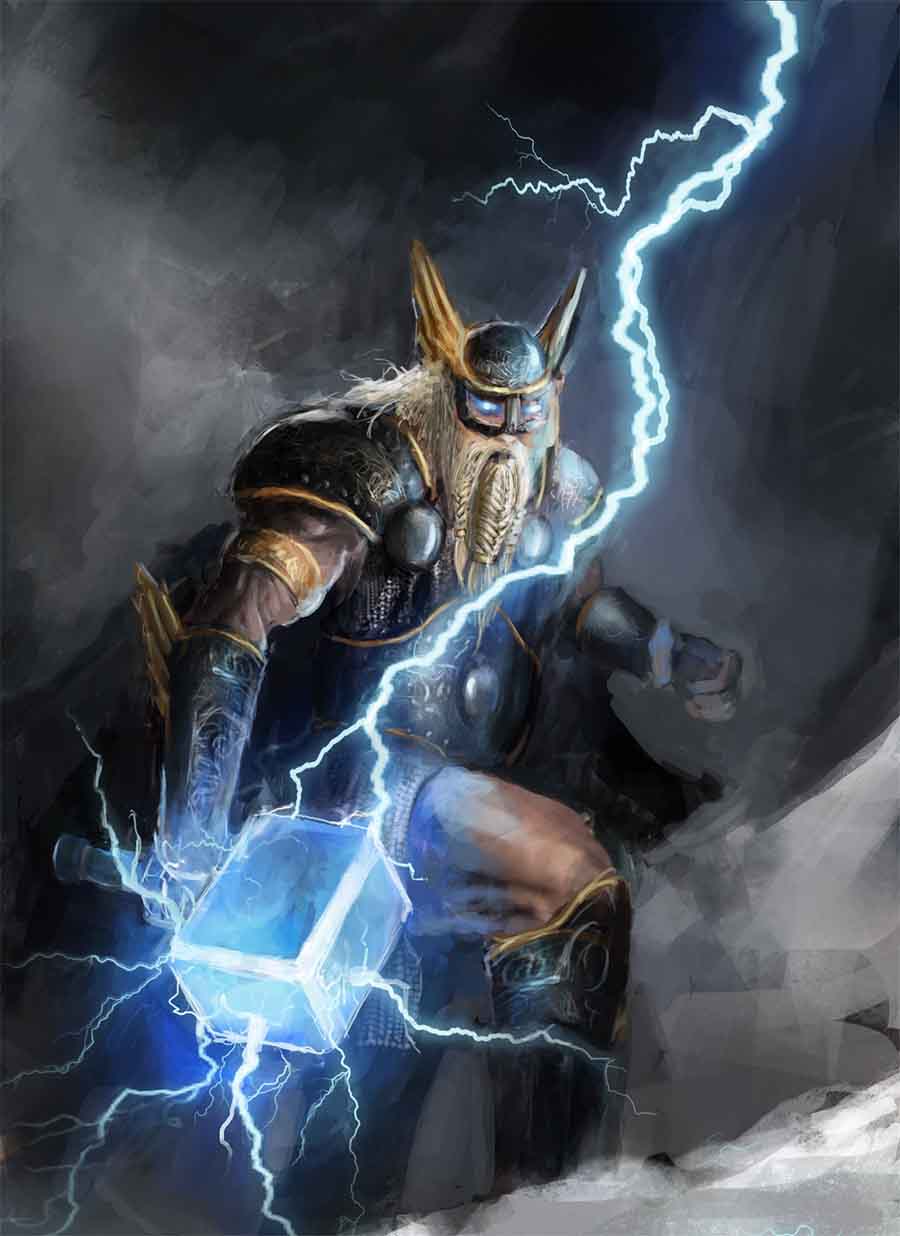
Thor, the Norse god of lightning, is one of Odin's sons and probably the most famous of Norse deities in popular culture today. (Dusan Kostic / Adobe Stock)
Odin Was the Father of Many Including the Great God Thor
The Norse also believed that Odin and his brothers created the first human beings, though this appears to be unconnected to the creation myth. According to this story, Odin and his brothers were walking along a beach when they came across two logs, one from an ash, and the other from an elm.
The gods decided to create humans out of the logs. Therefore, Odin gave the logs spirit and life, Ve gave them movement, mind, and intelligence, whilst Vili gave them shape, speech, feelings, and the five senses. The first man was called Ask, and the first woman Embla. The pair were placed by the gods in Midgard.
Odin was also the father of many of the other Norse gods. Odin’s wife was the goddess Frigg, with whom he had two sons, Baldur and Hod, who were direct opposites of each other. For instance, whilst Baldur represented light, Hod represented darkness (he is even depicted as being blind).
Odin also had sons with other women, many of whom were jotnar. For example, one of the best-known Norse gods, Thor, was the son of Odin and a jotunn named Jord. Another jotunn, Gridr, had a son, Vidarr, with Odin. According to prophecy, Vidarr, the god of vengeance, would avenge his father’s death during the Ragnarok. Another of Odin’s sons, Vali, was the offspring of the jotunn Rindr, and was destined to avenge the death of Baldur.
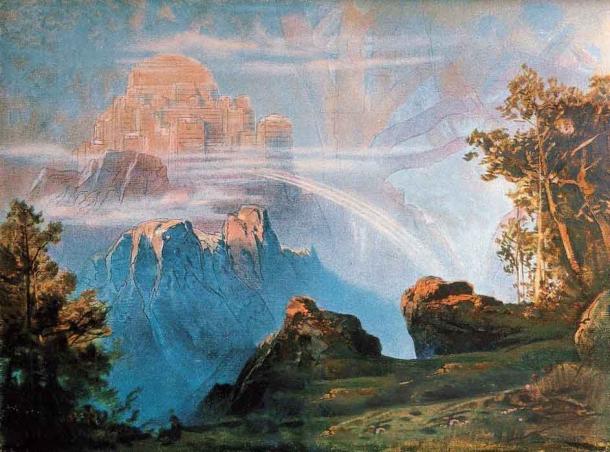
The heavenly palatial palace of Valhalla, depicted in this old painting by Max Brückner, was Odin's home. (Max Brückner (1836-1919) / Public domain)
Odin: The Norse God of War and His Palatial Valhalla Palace
In addition to his role as a creator god, Odin was worshipped as the Norse god of war. For instance, he was seen as a protector of Viking warriors. Additionally, the Norse thought that Odin never lost a battle, with some even believing that it was impossible for the god to lose a battle.
Most importantly, the Norse believed that those who died honorably in combat had the chance of entering Valhalla(meaning “Hall of the Slain”), Odin’s palatial home. The slain warriors are recruited by Odin’s daughters, the Valkyries (literally meaning “dead choosers”), and lived in Valhalla, where they would feast daily, and prepare for the final Ragnarok battle. On the day of the final battle these warriors, known as the einherjar, would fight alongside Odin and the rest of the Norse gods against their enemies.
Even though Odin was a warrior god, he did not win his battles with mere brute force and power. Indeed, the Norse also considered Odin to be a full of wisdom. Odin’s wisdom is most famously represented by his depiction as a one-eyed man. According to Norse mythology, the wisest god amongst the Aesir was Mimir, whose origin is not entirely clear. This god was renowned for his knowledge and prophetic wisdom.
In one myth, Mimir is depicted as the caretaker of the Well of Knowledge (known also as Mimir’s Well). Odin, in his quest for knowledge, journeys to this well, so that he could drink from it. Although Odin was allowed to drink from the well, he had to sacrifice one of his eyes for the privilege.
The Well of Knowledge is believed to be located in Jotunheim, the land of the giants, which suggests that Mimir was a jotunn. In another myth, however, Mimir is depicted as an Aesir. In this myth, the Aesir were at war with the Vanir, the other major group of Norse gods. In the end, the Aesir and Vanir made peace, and exchanged hostages.
On the one hand, the Vanir sent some of their most prized members, such as Njord, Freyr, and Freyja, to the Aesir. On the other hand, Aesir sent Mimir and Hoenir to the Vanir.
Whilst Mimir was a powerful god, Hoenir is said to have been a weak and indecisive deity. When the Vanir discovered this, they took it as an insult, and executed Mimir in retaliation. The god’s severed head was sent to Odin, who magically reanimated it.
Mimir’s head, therefore, became a source of knowledge, and Odin relied on its counsel when he needed to make important decisions.
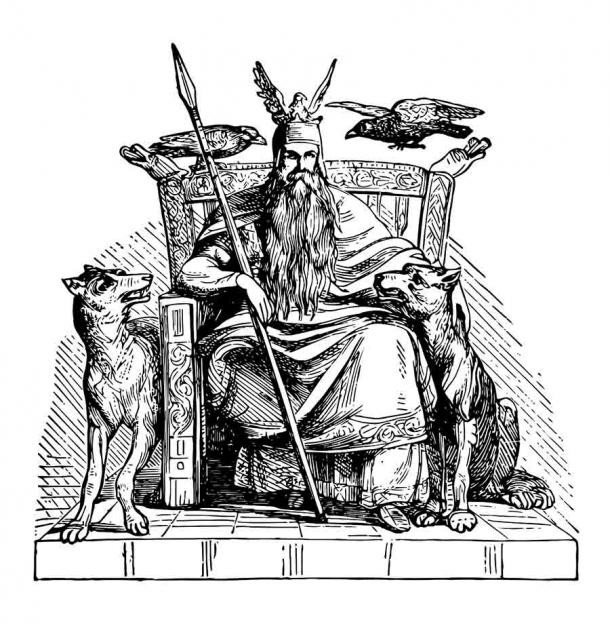
In this vintage illustration Odin is seated on his throne with his magical messengers: two ravens and two wolves. (Morphart / Adobe Stock)
The Source of Odin’s Knowledge and Wisdom: Ravens and Wolves
Mimir was not the only source of knowledge that Odin had access to. The Norse believe that the god kept a pair of ravens, Huginn and Muninn (whose names literally mean “Thought” and “Memory”). Each morning, the birds would travel across the Nine Worlds to observe all that was going on. At night, Huginn and Muninn would return to Odin, and report to him all they had seen. It was through these ravens that Odin learned about everything that went on in each realm.
Apart from the ravens, Odin also kept a pair of wolves, Grei and Freki (meaning “Ravenous,” and “Greedy One”). The pair were supposedly created when Odin felt lonely. In his role as a warrior god, the wolves were perfect companions for Odin, as they would scour the battlefield, and feast on those who died in battle. Additionally, Odin’s mount was an eight-legged horse named Sleipnir (meaning “Slipper”).
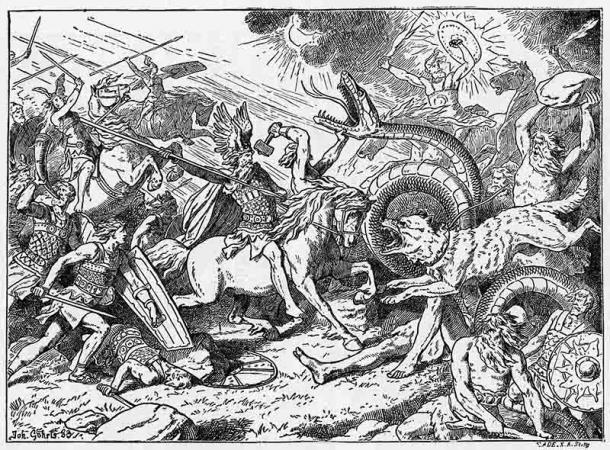
In the epic and final Ragnarok battle, Odin dies in the jaws of the wolf Fenrir. (Archivist / Adobe Stock)
Ragnarok: The Death of Odin in Fenrir’s Killer Wolf Jaws
Although Odin was an immensely powerful god, he too would perish one day, at the Ragnarok (meaning “Fate of the Gods”). The Norse believed that this would be the final battle at the end of the current cosmic order. The events of Ragnarok, including Odin’s own death, are said to have been prophesied by the god himself, but even he is powerless to prevent it from happening.
According to Norse mythology, Ragnarok will be preceded by a series of portents, including the birth of three monsters to Loki and Angrboda, his giantess wife, the death of Baldur, terrible winters, and the subversion of the cosmic order.
As Ragnarok approaches, the various combatants would converge on Vigrid (meaning ‘Field of Battle’), where the final battle would be fought. The gods, both Aesir and Vanir, and their followers would do battle with the forces of Loki and the jotnar. The gods would be led by Odin, wearing a gold helmet and hauberk, and armed Gungnir, his magical spear. At Ragnarok, Odin’s chief adversary was to be the Fenrir, the great wolf, and one of Loki’s offspring.
Odin foresaw that he would fight valiantly against the monstrous wolf but would, in the end, be devoured by it. Odin’s death, however, would be avenged by his son, Vidar, who rips apart Fenrir’s jaw, thereby killing the beast.
- More than Blood and Bling: Our Many Visions of the Vikings
- Ragnarok: Norse Account of Strange & Wonderful Land Doomed to Destruction – Part I
Although Ragnarok is depicted as a devastating event, it did not signal the end of the world. Odin prophesied that some of the gods would survive, in addition to a pair of humans, who would go on to repopulate the world.
Odin Remains The Chief Deity of Asir and the Norse Pantheon
To conclude, Odin is the chief deity of the Asir, and by extension, the Norse pantheon. This is clearly reflected in the fact that he is present in the major Norse myths from the creation of the world to the destruction of the current cosmos.
Although Odin is depicted as a warrior god, he is also believed to have been full of wisdom. Poetry, magic, and prophecy were also associated with this god. The last of these enabled Odin to foresee the events of Ragnarok.
Despite being a powerful god, and having won all the battles he fought, Odin was not invincible. This is almost human trait is well captured by Odin seeing his death in his fight with Fenrir at Ragnarok, and that he was powerless to change this fate.
Top image: An old wooden statue of the Norse God Odin standing alone on the shore of a lonely Scandinavian fjord. Source: drakuliren / Adobe Stock
By Wu Mingren
References
Apel, T., 2021. Odin. [Online]
Available at: https://mythopedia.com/norse-mythology/gods/odin/
Hstoriska, 2021. Odin – the one-eyed All-Father. [Online]
Available at: https://historiska.se/norse-mythology/odin-en/
Nationalmuseet i København, 2021. The gods of the old Nordic religion. [Online]
Available at: https://en.natmus.dk/historical-knowledge/denmark/prehistoric-period-unt...
New World Encyclopedia, 2021. Mimir. [Online]
Available at: https://www.newworldencyclopedia.org/entry/Mimir
New World Encyclopedia, 2021. Odin. [Online]
Available at: https://www.newworldencyclopedia.org/entry/Odin
New World Encyclopedia, 2021. Ragnarök. [Online]
Available at: https://www.newworldencyclopedia.org/entry/Ragnar%C3%B6k
Skjalden, 2011. Creation of the World in Norse Mythology. [Online]
Available at: https://skjalden.com/creation-of-the-world-in-norse-mythology/
Tacitus, On Germany [Online]
[Gordon, T. (trans.), 1910. Tacitus’ On Germany.]
Available at: https://www.gutenberg.org/files/2995/2995-h/2995-h.htm
The Editors of Encyclopaedia Britannica, 2018. Mimir. [Online]
Available at: https://www.britannica.com/topic/Mimir
The Editors of Encyclopaedia Britannica, 2021. Odin. [Online]
Available at: https://www.britannica.com/topic/Odin-Norse-deity
www.gods-and-goddesses.com, 2021. Odin. [Online]
Available at: https://www.gods-and-goddesses.com/norse/odin/


















